
Rutina Mochila
pt
(En
portugués)
Las rutinas son todas aquellas actividades o acciones que llevamos a cabo en nuestro día a día de manera regular y sistemática, es decir, se trata de hábitos o costumbres que adquirimos tras repetirlos muchas veces y que, posteriormente, realizamos de manera automática y sin que impliquen un sobre esfuerzo de razonamiento. Para muchas personas, niños/as y adultos/as, estas actividades diarias suponen un problema añadido a su día a día, por lo que es necesario trabajarlas desde la anticipación y la práctica diaria, marcando y reforzando cada uno de los pasos o secuencias de las que se componen. Comprender y automatizar estas tareas, se traduce en la comprensión y estructuración de sus días y del mundo que les rodea y en el cual deben interactuar y participar. Para esta comprensión y posterior automatización, se hace necesario un proceso importante de aprendizaje y apoyo, de ahí que hayamos creado, gracias a Eneso Verbo, una serie de tableros basados en rutinas diarias, con el objetivo de apoyar este proceso de anticipación, aprendizaje y automatización de las distintas rutinas diarias. Con este recurso trabajaremos las distintas secuencias necesarias para aprender la rutina de preparar la mochila para el cole.
Compartido por: Adapt4you

Hago pipí
es
Las rutinas son todas aquellas actividades o acciones que llevamos a cabo en nuestro día a día de manera regular y sistemática, es decir, se trata de hábitos o costumbres que adquirimos tras repetirlos muchas veces y que, posteriormente, realizamos de manera automática y sin que impliquen un sobre esfuerzo de razonamiento. Para muchas personas, niños/as y adultos/as, estas actividades diarias suponen un problema añadido a su día a día, por lo que es necesario trabajarlas desde la anticipación y la práctica diaria, marcando y reforzando cada uno de los pasos o secuencias de las que se componen. Comprender y automatizar estas tareas, se traduce en la comprensión y estructuración de sus días y del mundo que les rodea y en el cual deben interactuar y participar. Para esta comprensión y posterior automatización, se hace necesario un proceso importante de aprendizaje y apoyo, de ahí que hayamos creado, gracias a Eneso Verbo, una serie de tableros basados en rutinas diarias, con el objetivo de apoyar este proceso de anticipación, aprendizaje y automatización de las distintas rutinas diarias. Con este recurso trabajaremos las distintas secuencias necesarias para aprender la rutina de hacer pipí.
Compartido por: Eneso

Preparo mi mochila para el cole
es
Las rutinas son todas aquellas actividades o acciones que llevamos a cabo en nuestro día a día de manera regular y sistemática, es decir, se trata de hábitos o costumbres que adquirimos tras repetirlos muchas veces y que, posteriormente, realizamos de manera automática y sin que impliquen un sobre esfuerzo de razonamiento. Para muchas personas, niños/as y adultos/as, estas actividades diarias suponen un problema añadido a su día a día, por lo que es necesario trabajarlas desde la anticipación y la práctica diaria, marcando y reforzando cada uno de los pasos o secuencias de las que se componen. Comprender y automatizar estas tareas, se traduce en la comprensión y estructuración de sus días y del mundo que les rodea y en el cual deben interactuar y participar. Para esta comprensión y posterior automatización, se hace necesario un proceso importante de aprendizaje y apoyo, de ahí que hayamos creado, gracias a Eneso Verbo, una serie de tableros basados en rutinas diarias, con el objetivo de apoyar este proceso de anticipación, aprendizaje y automatización de las distintas rutinas diarias. Con este recurso trabajaremos las distintas secuencias necesarias para aprender la rutina de preparar la mochila para el cole.
Compartido por: Eneso

Ponemos la mesa
es
Las rutinas son todas aquellas actividades o acciones que llevamos a cabo en nuestro día a día de manera regular y sistemática, es decir, se trata de hábitos o costumbres que adquirimos tras repetirlos muchas veces y que, posteriormente, realizamos de manera automática y sin que impliquen un sobre esfuerzo de razonamiento. Para muchas personas, niños/as y adultos/as, estas actividades diarias suponen un problema añadido a su día a día, por lo que es necesario trabajarlas desde la anticipación y la práctica diaria, marcando y reforzando cada uno de los pasos o secuencias de las que se componen. Comprender y automatizar estas tareas, se traduce en la comprensión y estructuración de sus días y del mundo que les rodea y en el cual deben interactuar y participar. Para esta comprensión y posterior automatización, se hace necesario un proceso importante de aprendizaje y apoyo, de ahí que hayamos creado, gracias a Eneso Verbo, una serie de tableros basados en rutinas diarias, con el objetivo de apoyar este proceso de anticipación, aprendizaje y automatización de las distintas rutinas diarias. Con este recurso trabajaremos las distintas secuencias necesarias para aprender la rutina de poner la mesa.
Compartido por: Eneso

Me lavo las manos
es
Las rutinas son todas aquellas actividades o acciones que llevamos a cabo en nuestro día a día de manera regular y sistemática, es decir, se trata de hábitos o costumbres que adquirimos tras repetirlos muchas veces y que, posteriormente, realizamos de manera automática y sin que impliquen un sobre esfuerzo de razonamiento. Para muchas personas, niños/as y adultos/as, estas actividades diarias suponen un problema añadido a su día a día, por lo que es necesario trabajarlas desde la anticipación y la práctica diaria, marcando y reforzando cada uno de los pasos o secuencias de las que se componen. Comprender y automatizar estas tareas, se traduce en la comprensión y estructuración de sus días y del mundo que les rodea y en el cual deben interactuar y participar. Para esta comprensión y posterior automatización, se hace necesario un proceso importante de aprendizaje y apoyo, de ahí que hayamos creado, gracias a Eneso Verbo, una serie de tableros basados en rutinas diarias, con el objetivo de apoyar este proceso de anticipación, aprendizaje y automatización de las distintas rutinas diarias. Con este recurso trabajaremos las distintas secuencias necesarias para aprender la rutina de lavarse las manos.
Compartido por: Eneso

Rutina facial
es
Las rutinas son todas aquellas actividades o acciones que llevamos a cabo en nuestro día a día de manera regular y sistemática, es decir, se trata de hábitos o costumbres que adquirimos tras repetirlos muchas veces y que, posteriormente, realizamos de manera automática y sin que impliquen un sobre esfuerzo de razonamiento. Para muchas personas, niños/as y adultos/as, estas actividades diarias suponen un problema añadido a su día a día, por lo que es necesario trabajarlas desde la anticipación y la práctica diaria, marcando y reforzando cada uno de los pasos o secuencias de las que se componen. Comprender y automatizar estas tareas, se traduce en la comprensión y estructuración de sus días y del mundo que les rodea y en el cual deben interactuar y participar. Para esta comprensión y posterior automatización, se hace necesario un proceso importante de aprendizaje y apoyo, de ahí que hayamos creado, gracias a Eneso Verbo, una serie de tableros basados en rutinas diarias, con el objetivo de apoyar este proceso de anticipación, aprendizaje y automatización de las distintas rutinas diarias. Con este recurso trabajaremos las distintas secuencias necesarias para aprender la rutina de cuidarse la cara y hacer un correcto skincare.
Compartido por: Eneso

Hora de dormir
es
Las rutinas son todas aquellas actividades o acciones que llevamos a cabo en nuestro día a día de manera regular y sistemática, es decir, se trata de hábitos o costumbres que adquirimos tras repetirlos muchas veces y que, posteriormente, realizamos de manera automática y sin que impliquen un sobre esfuerzo de razonamiento. Para muchas personas, niños/as y adultos/as, estas actividades diarias suponen un problema añadido a su día a día, por lo que es necesario trabajarlas desde la anticipación y la práctica diaria, marcando y reforzando cada uno de los pasos o secuencias de las que se componen. Comprender y automatizar estas tareas, se traduce en la comprensión y estructuración de sus días y del mundo que les rodea y en el cual deben interactuar y participar. Para esta comprensión y posterior automatización, se hace necesario un proceso importante de aprendizaje y apoyo, de ahí que hayamos creado, gracias a Eneso Verbo, una serie de tableros basados en rutinas diarias, con el objetivo de apoyar este proceso de anticipación, aprendizaje y automatización de las distintas rutinas diarias. Con este recurso trabajaremos las distintas secuencias necesarias para aprender la rutina de irse a dormir.
Compartido por: Eneso

Me lavo los dientes
es
Las rutinas son todas aquellas actividades o acciones que llevamos a cabo en nuestro día a día de manera regular y sistemática, es decir, se trata de hábitos o costumbres que adquirimos tras repetirlos muchas veces y que, posteriormente, realizamos de manera automática y sin que impliquen un sobre esfuerzo de razonamiento. Para muchas personas, niños/as y adultos/as, estas actividades diarias suponen un problema añadido a su día a día, por lo que es necesario trabajarlas desde la anticipación y la práctica diaria, marcando y reforzando cada uno de los pasos o secuencias de las que se componen. Comprender y automatizar estas tareas, se traduce en la comprensión y estructuración de sus días y del mundo que les rodea y en el cual deben interactuar y participar. Para esta comprensión y posterior automatización, se hace necesario un proceso importante de aprendizaje y apoyo, de ahí que hayamos creado, gracias a Eneso Verbo, una serie de tableros basados en rutinas diarias, con el objetivo de apoyar este proceso de anticipación, aprendizaje y automatización de las distintas rutinas diarias. Con este recurso trabajaremos las distintas secuencias necesarias para aprender la rutina de lavarse los dientes.
Compartido por: Eneso

En el comedor
es
Las rutinas son todas aquellas actividades o acciones que llevamos a cabo en nuestro día a día de manera regular y sistemática, es decir, se trata de hábitos o costumbres que adquirimos tras repetirlos muchas veces y que, posteriormente, realizamos de manera automática y sin que impliquen un sobre esfuerzo de razonamiento. Para muchas personas, niños/as y adultos/as, estas actividades diarias suponen un problema añadido a su día a día, por lo que es necesario trabajarlas desde la anticipación y la práctica diaria, marcando y reforzando cada uno de los pasos o secuencias de las que se componen. Comprender y automatizar estas tareas, se traduce en la comprensión y estructuración de sus días y del mundo que les rodea y en el cual deben interactuar y participar. Para esta comprensión y posterior automatización, se hace necesario un proceso importante de aprendizaje y apoyo, de ahí que hayamos creado, gracias a Eneso Verbo, una serie de tableros basados en rutinas diarias, con el objetivo de apoyar este proceso de anticipación, aprendizaje y automatización de las distintas rutinas diarias. Con este recurso trabajaremos las distintas secuencias necesarias para aprender la rutina de comer en el comedor.
Compartido por: Eneso

Me lavo la cara
es
Las rutinas son todas aquellas actividades o acciones que llevamos a cabo en nuestro día a día de manera regular y sistemática, es decir, se trata de hábitos o costumbres que adquirimos tras repetirlos muchas veces y que, posteriormente, realizamos de manera automática y sin que impliquen un sobre esfuerzo de razonamiento. Para muchas personas, niños/as y adultos/as, estas actividades diarias suponen un problema añadido a su día a día, por lo que es necesario trabajarlas desde la anticipación y la práctica diaria, marcando y reforzando cada uno de los pasos o secuencias de las que se componen. Comprender y automatizar estas tareas, se traduce en la comprensión y estructuración de sus días y del mundo que les rodea y en el cual deben interactuar y participar. Para esta comprensión y posterior automatización, se hace necesario un proceso importante de aprendizaje y apoyo, de ahí que hayamos creado, gracias a Eneso Verbo, una serie de tableros basados en rutinas diarias, con el objetivo de apoyar este proceso de anticipación, aprendizaje y automatización de las distintas rutinas diarias. Con este recurso trabajaremos las distintas secuencias necesarias para aprender la rutina de lavarse la cara.
Compartido por: Eneso

Hago caca
es
Las rutinas son todas aquellas actividades o acciones que llevamos a cabo en nuestro día a día de manera regular y sistemática, es decir, se trata de hábitos o costumbres que adquirimos tras repetirlos muchas veces y que, posteriormente, realizamos de manera automática y sin que impliquen un sobre esfuerzo de razonamiento. Para muchas personas, niños/as y adultos/as, estas actividades diarias suponen un problema añadido a su día a día, por lo que es necesario trabajarlas desde la anticipación y la práctica diaria, marcando y reforzando cada uno de los pasos o secuencias de las que se componen. Comprender y automatizar estas tareas, se traduce en la comprensión y estructuración de sus días y del mundo que les rodea y en el cual deben interactuar y participar. Para esta comprensión y posterior automatización, se hace necesario un proceso importante de aprendizaje y apoyo, de ahí que hayamos creado, gracias a Eneso Verbo, una serie de tableros basados en rutinas diarias, con el objetivo de apoyar este proceso de anticipación, aprendizaje y automatización de las distintas rutinas diarias. Con este recurso trabajaremos las distintas secuencias necesarias para aprender la rutina de hacer caca.
Compartido por: Eneso

Juego de suma sencillo
pt
(En
portugués)
Actividad de suma simple con números enteros. Según el cálculo propuesto en cada nivel, la manzana con la respuesta correcta.
Compartido por: Adapt4you

Reproductor
es
Página complementaria para añadir a los tableros y tener siempre un reproductor en tu tablero de comunicación.
Podrás descargarla e importarla a tus tableros (tableros de comunicación, actividades, juegos, etc.) con los que ya trabajes o te comuniques.
Compartido por: Eneso

Rutina Playa
pt
(En
portugués)
Las rutinas son todas aquellas actividades o acciones que llevamos a cabo en nuestro día a día de manera regular y sistemática, es decir, se trata de hábitos o costumbres que adquirimos tras repetirlos muchas veces y que, posteriormente, realizamos de manera automática y sin que impliquen un sobre esfuerzo de razonamiento. Para muchas personas, niños/as y adultos/as, estas actividades diarias suponen un problema añadido a su día a día, por lo que es necesario trabajarlas desde la anticipación y la práctica diaria, marcando y reforzando cada uno de los pasos o secuencias de las que se componen. Comprender y automatizar estas tareas, se traduce en la comprensión y estructuración de sus días y del mundo que les rodea y en el cual deben interactuar y participar. Para esta comprensión y posterior automatización, se hace necesario un proceso importante de aprendizaje y apoyo, de ahí que hayamos creado, gracias a Eneso Verbo, una serie de tableros basados en rutinas diarias, con el objetivo de apoyar este proceso de anticipación, aprendizaje y automatización de las distintas rutinas diarias. Con este recurso trabajaremos las distintas secuencias necesarias para aprender la rutina de ir a la playa.
Compartido por: Adapt4you

Rutina Piscina
pt
(En
portugués)
Para muchas personas, niños/as y adultos/as, estas actividades diarias suponen un problema añadido a su día a día, por lo que es necesario trabajarlas desde la anticipación y la práctica diaria, marcando y reforzando cada uno de los pasos o secuencias de las que se componen. Comprender y automatizar estas tareas, se traduce en la comprensión y estructuración de sus días y del mundo que les rodea y en el cual deben interactuar y participar. Para esta comprensión y posterior automatización, se hace necesario un proceso importante de aprendizaje y apoyo, de ahí que hayamos creado, gracias a Eneso Verbo, una serie de tableros basados en rutinas diarias, con el objetivo de apoyar este proceso de anticipación, aprendizaje y automatización de las distintas rutinas diarias. Con este recurso trabajaremos las distintas secuencias necesarias para aprender la rutina de ir a la piscina.
Compartido por: Adapt4you

Rutina: ¡Vamos a la piscina!
es
Para muchas personas, niños/as y adultos/as, estas actividades diarias suponen un problema añadido a su día a día, por lo que es necesario trabajarlas desde la anticipación y la práctica diaria, marcando y reforzando cada uno de los pasos o secuencias de las que se componen.
Comprender y automatizar estas tareas, se traduce en la comprensión y estructuración de sus días y del mundo que les rodea y en el cual deben interactuar y participar. Para esta comprensión y posterior automatización, se hace necesario un proceso importante de aprendizaje y apoyo, de ahí que hayamos creado, gracias a Eneso Verbo, una serie de tableros basados en rutinas diarias, con el objetivo de apoyar este proceso de anticipación, aprendizaje y automatización de las distintas rutinas diarias.
Con este recurso trabajaremos las distintas secuencias necesarias para aprender la rutina de ir a la piscina.
Compartido por: Eneso

Rutina: ¡Vamos a la playa!
es
Las rutinas son todas aquellas actividades o acciones que llevamos a cabo en nuestro día a día de manera regular y sistemática, es decir, se trata de hábitos o costumbres que adquirimos tras repetirlos muchas veces y que, posteriormente, realizamos de manera automática y sin que impliquen un sobre esfuerzo de razonamiento.
Para muchas personas, niños/as y adultos/as, estas actividades diarias suponen un problema añadido a su día a día, por lo que es necesario trabajarlas desde la anticipación y la práctica diaria, marcando y reforzando cada uno de los pasos o secuencias de las que se componen.
Comprender y automatizar estas tareas, se traduce en la comprensión y estructuración de sus días y del mundo que les rodea y en el cual deben interactuar y participar. Para esta comprensión y posterior automatización, se hace necesario un proceso importante de aprendizaje y apoyo, de ahí que hayamos creado, gracias a Eneso Verbo, una serie de tableros basados en rutinas diarias, con el objetivo de apoyar este proceso de anticipación, aprendizaje y automatización de las distintas rutinas diarias.
Con este recurso trabajaremos las distintas secuencias necesarias para aprender la rutina de ir a la playa.
Compartido por: Eneso
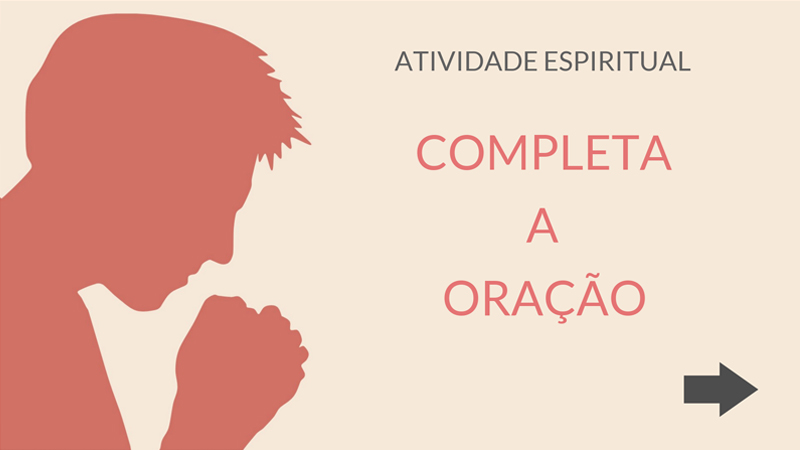
Completa la Oración
pt
(En
portugués)
Actividad con varias oraciones de la religión cristiana. El objetivo es completar las frases con las palabras disponibles. ¡Gran actividad para trabajar la memoria! Ideal para adultos y personas mayores que son religiosas.
Compartido por: Adapt4you

Sinónimos-Antónimos
pt
(En
portugués)
Los sinónimos son palabras distintas pero que significan lo mismo, mientras que los antónimos son palabras que significan lo contrario. A priori son dos conceptos que parecen fáciles de entender y poner en práctica, pero que en la realidad resultan trabajosos y complicados, debido a que se trata de dos conceptos opuestos. Con este nuevo recurso de material curricular adaptado queremos enseñar qué son y cómo pueden enriquecer nuestro lenguaje cotidiano los sinónimos y los antónimos, ya que son grandes aliados en los procesos de construcción del léxico y en los procesos de lectoescritura. Este material se compone de una breve explicación con ejemplos y tres actividades diferentes, una de ellas que funciona a través de un enlace externo que le llevará a una página web. Las diferentes actividades que componen esta adaptación de material curricular nos ofrecen la posibilidad de guardar las respuestas dadas para valorarlas con detenimiento o utilizar el material como examen adaptado.
Compartido por: Adapt4you
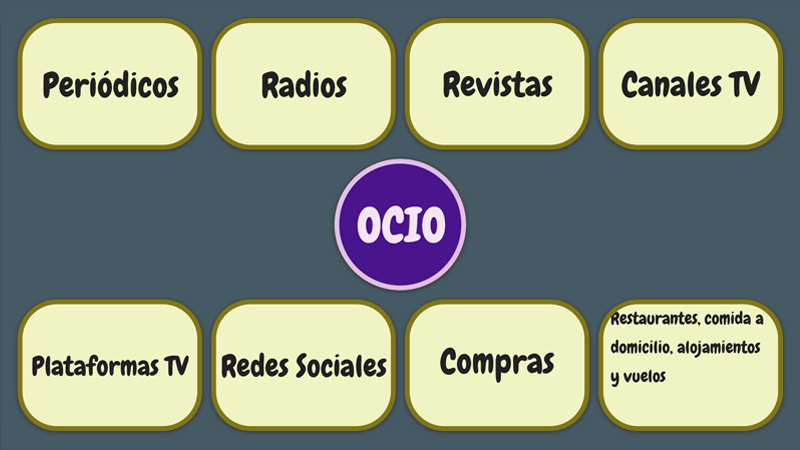
Ocio
es
Este nuevo recurso creado con Eneso Verbo presenta una serie de páginas donde encontraremos diferentes celdas que nos permitirán disfrutar de nuestro tiempo de ocio desde nuestro comunicador.
Las páginas se constituyen por categorías, como: periódicos, canales de televisión, radios, redes sociales, plataformas, hostelería y viajes, compras, entre otras.
En cada página encontraremos diferentes celdas que nos llevarán directamente a un canal on line de televisión, a un periódico concreto, a la web de una tienda, a una plataforma, a un buscador de hoteles, etc.
Puedes utilizar este recurso como tablero único para disfrutar tu ocio, puedes importar las páginas que te interesen a tu tablero de comunicación, o puedes seleccionar aquellas celdas que sean de tu interés y uso cotidiano para crear tu propio tablero de ocio.
Compartido por: Eneso

Colorea Italia - 25 de abril
it
(En
italiano)
Actividad para colorear con los colores de la bandera italiana para celebrar el 25 de abril.
Compartido por: Benelli Massimo

Reglas de acentuación
es
Las reglas de acentuación determinan dónde y cuándo llevarán tilde las palabras, además de proporcionarnos información sobre aquellas palabras que, independientemente de las reglas básicas de acentuación, llevarán tilde por su propia peculiaridad y características.
Aplicar las reglas de acentuación implica implica que sepamos dividir la palabra en sílabas, que entendamos qué es una sílaba tónica y una sílaba átona y, por último, que sepamos diferenciar los tipos de palabras más básicas (llanas, agudas y esdrújulas), además de entender cuando llevarán tilde cada una de ellas.
Con este nuevo recurso aprenderemos, de manera dinámica, qué son las sílabas átonas y tónicas, cuáles son las palabras llanas, agudas y esdrújulas y cómo y cuándo acentuarlas.
Las diferentes actividades que componen esta adaptación de material curricular, nos brindan la posibilidad de guardar las respuestas que den los/as usuarios/as y así valorarlas con detenimiento o utilizar el material como examen adaptado.
Compartido por: Eneso

Prefijos y sufijos
es
Hemos creado este tablero para explicar y trabajar prefijos y sufijos, que son elementos gramaticales que cambian el significado de la palabra que acompañan.
Este nuevo recurso de material curricular se compone de una breve explicación con ejemplos y actividades para afianzar los conocimientos trabajados.
Las diferentes actividades que componen esta adaptación de material curricular nos ofrecen la posibilidad de guardar las respuestas dadas para valorarlas con detenimiento o utilizar el material como examen adaptado.
Compartido por: Eneso

Sinónimos y antónimos
es
Los sinónimos son palabras distintas pero que significan lo mismo, mientras que los antónimos son palabras que significan lo contrario. A priori son dos conceptos que parecen fáciles de entender y poner en práctica, pero que en la realidad resultan trabajosos y complicados, debido a que se trata de dos conceptos opuestos.
Con este nuevo recurso de material curricular adaptado queremos enseñar qué son y cómo pueden enriquecer nuestro lenguaje cotidiano los sinónimos y los antónimos, ya que son grandes aliados en los procesos de construcción del léxico y en los procesos de lectoescritura.
Este material se compone de una breve explicación con ejemplos y tres actividades diferentes, una de ellas que funciona a través de un enlace externo que le llevará a una página web.
Las diferentes actividades que componen esta adaptación de material curricular nos ofrecen la posibilidad de guardar las respuestas dadas para valorarlas con detenimiento o utilizar el material como examen adaptado.
Compartido por: Eneso

Sujeto y predicado
es
Aprender cómo se estructura una oración simple y ser capaces de diferencias las partes que la componen es importante para el correcto desarrollo del lenguaje, tanto verbal como no verbal. Con este nuevo tablero queremos trabajar de manera dinámica las oraciones atendiendo a esas cuestiones, comprendiendo cuál es la diferencia entre sujeto y predicado, cómo identificarlos y qué papel desarrolla cada uno.
El material cuenta con una breve pero precisa explicación y una serie de actividades para afianzar los conocimientos trabajados.
Las diferentes actividades que componen este tablero nos ofrece la posibilidad de guardas las respuestas de las y los usuarios para poder valorarlas con detenimiento y corregirlas, dando la opción de usar este material como examen adaptado.
Compartido por: Eneso

Masculino y femenino
es
El tablero Masculino y Femenino nos permite aprender y trabajar, de manera dinámica y divertida, el género de las palabras, saber distinguirlo y poder utilizarlo correctamente en una oración, un texto o una situación comunicativa.
El material cuenta con explicaciones y actividades que reforzarán el proceso de aprendizaje.
Las diferentes actividades que componen esta adaptación de material curricular, nos brindan la posibilidad de guardar las respuestas que den los/as usuarios/as y así valorarlas con detenimiento o utilizar el material como examen adaptado.
Compartido por: Eneso

Singular y plural
es
El tablero Singular y Plural nos permite aprender y trabajar, de manera dinámica y divertida, el número de las palabras, saber distinguirlo y poder utilizarlo correctamente en una oración, un texto o una situación comunicativa.
El material cuenta con explicaciones y actividades que reforzarán el proceso de aprendizaje.
Las diferentes actividades que componen esta adaptación de material curricular, nos brindan la posibilidad de guardar las respuestas que den los/as usuarios/as y así valorarlas con detenimiento o utilizar el material como examen adaptado.
Compartido por: Eneso

Números romanos
es
Antes de que los árabes trajesen a Europa su sistema de numeración, que es el que utilizamos hoy en día, hace mucho tiempo, en la Antigua Roma, los romanos inventaron un sistema de numeración que todavía seguimos utilizando para algunas cosas. Son lo que llamamos números romanos.
Con este tablero podremos aprender qué son, para qué y cómo se usan los números romanos. Encontrarás una breve explicación con ejemplos y las reglas básicas, y tres actividades para afianzar y repasar lo aprendido.
Compartido por: Eneso

Divisiones
es
La finalidad de las matemáticas en educación primaria es construir los fundamentos del razonamiento lógico – matemático, ya que es imprescindible hacer que el alumnado reflexione y no limitar su educación a la memorización de conceptos.
Es por eso por lo que hemos creado una serie de tableros donde podemos trabajar las operaciones aritméticas básicas (sumas, restas, multiplicación y división) al mismo tiempo que potenciamos la resolución de problemas y cálculo mental.
El tablero Divisiones contiene una breve explicación con ejemplos y una serie de actividades: operaciones, con dos niveles de dificultad, y problemas.
Compartido por: Eneso

Multiplicaciones
es
Hemos creado una serie de tableros donde podemos trabajar las operaciones aritméticas básicas (sumas, restas, multiplicación y división) al mismo tiempo que potenciamos la resolución de problemas y cálculo mental.
La finalidad de las matemáticas en educación primaria es construir los fundamentos del razonamiento lógico – matemático, ya que es imprescindible hacer que el alumnado reflexione y no limitar su educación a la memorización de conceptos.
En el tablero Multiplicaciones contiene una breve explicación con ejemplos, las tablas de multiplicar del 1 al 10, una actividad para repasar las tablas, una serie de multiplicaciones divididas en dos niveles de dificultad y problemas, donde el usuario deberá reflexionar antes de hacer las operaciones.
Compartido por: Eneso

Sumas y restas
es
La finalidad de las matemáticas en educación primaria es construir los fundamentos del razonamiento lógico – matemático, ya que es imprescindible hacer que el alumnado reflexione y no limitar su educación a la memorización de conceptos.
Es por eso por lo que hemos creado una serie de tableros donde podemos trabajar las operaciones aritméticas básicas (sumas, restas, multiplicación y división) al mismo tiempo que potenciamos la resolución de problemas y cálculo mental.
En el tablero Sumas y restas contiene una breve explicación con ejemplos de ambas operaciones y una serie de actividades ordenadas en tres niveles de dificultad.
Compartido por: Eneso

Adverbios
es
Para cerrar la serie de tableros con los que trabajar las categorizas gramaticales, os dejamos este recurso para trabajar los adverbios. Como en todas las categorías gramaticales, se trata de un tipo de palabras que presentan bastante dificultad en su proceso de aprendizaje, por lo que requieren trabajo, práctica y apoyo para su comprensión, asimilación, aprendizaje y reconocimiento. Con este material podremos trabajarlos de manera dinámica ya que cuenta con explicaciones y ejemplos de todas las características y tipos de adverbios, además de actividades que apoyan la comprensión y el aprendizaje de los mismos. Las diferentes actividades que componen esta adaptación de material curricular, nos brindan la posibilidad de guardar las respuestas que den los/as usuarios/as y así valorarlas con detenimiento o utilizar el material como examen adaptado.
Compartido por: Eneso
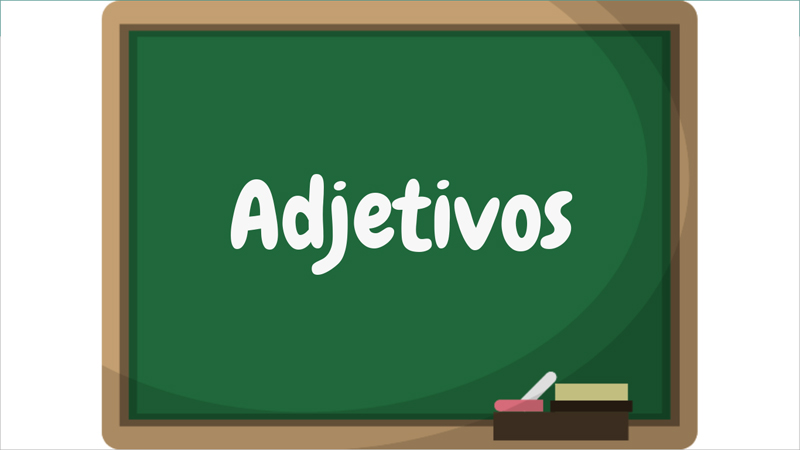
Adjetivos
es
Los adjetivos son aquellas palabras que acompañan al nombre o sustantivo, añadiendo información sobre él, como una cualidad o una característica que complementa su significado. Siempre concuerdan en género y número con los nombres o sustantivos.
Se trata de un tipo de palabra que guardan cierta complejidad debido a los diferentes usos que presenta y los diferentes grados en los que podemos usarlas.
Por ello, hemos desarrollado este recurso adaptado, con el objetivo de favorecer la compresión, la asimilación y el aprendizaje de los adjetivos, sus características, sus usos y sus grados.
Las diferentes actividades que componen esta adaptación de material curricular, nos brindan la posibilidad de guardar las respuestas que den los/as usuarios/as y así valorarlas con detenimiento o utilizar el material como examen adaptado.
Compartido por: Eneso

Verbos
es
Hemos preparado un tablero con el que trabajar los Verbos. Otro tipo de palabras que cuentan con bastante dificultad en su proceso de aprendizaje, por lo que necesitan bastante trabajo, práctica y apoyo para su comprensión, asimilación, aprendizaje y reconocimiento.
Con este material podremos trabajarlos de manera dinámica ya que cuenta con explicaciones y ejemplos de todas las características y peculiaridades de los verbos y actividades que apoyan la comprensión y el aprendizaje de los mismos.
Las diferentes actividades que componen esta adaptación de material curricular, nos brindan la posibilidad de guardar las respuestas que den los/as usuarios/as y así valorarlas con detenimiento o utilizar el material como examen adaptado.
Compartido por: Eneso

Pronombres
es
Le toca el turno a los pronombres. Otro tipo de palabras, que al igual que pasa con los determinantes y nombres o sustantivos, necesitan de trabajo, práctica y apoyo para su comprensión, asimilación, aprendizaje y reconocimiento. Con este material podremos trabajarlos de manera dinámica ya que cuenta con explicaciones y ejemplos de todos los tipos de pronombres y actividades que apoyan la comprensión y el aprendizaje de los mismos. Las diferentes actividades que componen esta adaptación de material curricular, nos brindan la posibilidad de guardar las respuestas que den los/as usuarios/as y así valorarlas con detenimiento o utilizar el material como examen adaptado.
Compartido por: Eneso

Nombres
es
Al igual que pasa con los determinantes, los nombres o sustantivos son un tipo de palabra que causa ciertos problemas en la asimilación y el aprendizaje de los mismos. Sus tipos, sus usos y el aprendizaje, la asimilación, el reconocimiento y la puesta en práctica de este tipo de palabras no es tarea fácil cuando nos enfrentamos a ellos y requieren de mucha práctica. Con este material podremos trabajarlos de manera dinámica ya que cuenta con explicaciones y ejemplos de todos los tipos de nombres o sustantivos y actividades que apoyan la comprensión y el aprendizaje de estos. Las diferentes actividades que componen esta adaptación de material curricular nos brindan la posibilidad de guardar las respuestas que den los/as usuarios/as y así valorarlas con detenimiento o utilizar el material como examen adaptado.
Compartido por: Eneso

Determinantes
es
Los determinantes son aquellas palabras que acompañan a un nombre o sustantivo, con el objetivo de concretarlo o determinarlo, aportando información sobre su género, número, situación en el espacio o posesión. Este concepto, en multitud de ocasiones, muestra problemas en la asimilación y el aprendizaje del mismo, de ahí que con este nuevo recurso propongamos una adaptación de material curricular con el que trabajar la compresión y el aprendizaje de los determinantes, sus tipos y los diferentes usos de cada uno de ellos. Las diferentes actividades que componen esta adaptación de material curricular nos brindan la posibilidad de guardar las respuestas que den los/as usuarios/as y así valorarlas con detenimiento o utilizar el material como examen adaptado.
Compartido por: Eneso

Agendas y rutinas
es
Con este tablero podrás organizar tu día, tu semana, y rutinas de 3, 6 y 8 pasos, aprendiendo a controlar el tiempo y a priorizar, entender y realizar cada una de las tareas incluidas en tu rutina.
Este recurso es especialmente útil para niños, que podrán completar las rutinas con sus padres o tutores, ayudándoles a sentirse seguros y con el control de su tiempo y obligaciones.
También es interesante para personas más mayores o de la tercera edad, que podrán trabajar la organización de sus actividades y tareas de una manera útil y llamativa.
Compartido por: Eneso

Tangram
pt
(En
portugués)
Actividad basada en el juego “Tangram”. A través de este recurso, en el que adaptamos y creamos una versión interactiva de Tangram, podemos crear diferentes figuras mientras trabajamos el reconocimiento de colores y formas geométricas planas.
Compartido por: Adapt4you

Colorea a la araña Rita
pt
(En
portugués)
Actividad en la que trabajaremos, a través de un juego, la discriminación visual y el reconocimiento de colores. La discriminación visual es la habilidad mediante la cual los niños pueden distinguir las diferentes propiedades de los objetos que les rodean, ayudándoles a diferenciarlos y clasificarlos por color, forma, posición, tamaño, etc. Es muy importante trabajar y desarrollar esta habilidad, ya que es un precursor del desarrollo del pensamiento lógico y matemático. Con Little Spider Rita trabajaremos la discriminación visual reconociendo y seleccionando los colores que nos pide, mientras trabajamos las instrucciones básicas, la atención, la concentración y la memoria. Objetivos: Trabajar la atención, la concentración, la memoria y la discriminación visual. Fortalecer la discriminación y el reconocimiento del color. Ejecutar y seguir las instrucciones básicas.
Compartido por: Adapt4you

Sudoku
es
El Sudoku es un pasatiempo de lógica, cuyo objetivo es rellenar las casillas ayudándonos de las imágenes, números o letras que ya estén colocados, sin repetir ninguno de ellos en la misma fila o columna.
Hemos adaptado el sudoku para hacerlo accesible desde Verbo y contar con esta actividad entre las muchas que forman la biblioteca de la Comunidad Verbo, ya que se trata de un gran recurso para trabajar lógica, razonamiento, atención, memoria y concentración.
Trabajar los sudokus con los/as niños/as, desde edades tempranas, y con personas mayores en intervención y estimulación cognitiva, conlleva numerosos beneficios para todos/as ellos/as, ya que implicar pensar a través de secuencias, desarrollar la comprensión espacial, el reconocimiento de patrones y la toma de decisiones al elegir el elemento que debemos de colocar en cada casilla.
Compartido por: Eneso

La constitución
it
(En
italiano)
Actividad interactiva sobre la constitución italiana.
Compartido por: Benelli Massimo

Tangram
es
Actividad basada en el juego del “Tangram”. A través de este recurso, en el que hemos adaptado y creado una versión interactiva del Tangram, podremos crear diferentes figuras al mismo tiempo que trabajamos reconocimiento de colores y de formas geométricas planas.
Compartido por: Eneso
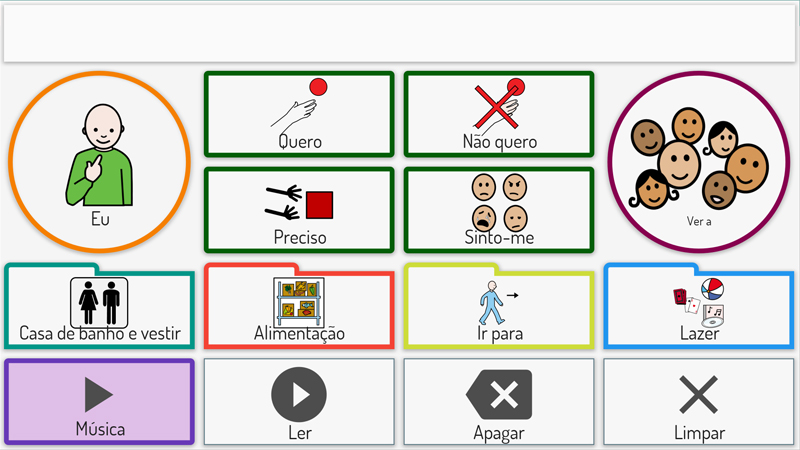
Actividades básicas
pt
(En
portugués)
Tablero de actividades básicas.
Compartido por: Ana

Bandera Ucraniana
it
(En
italiano)
Colorea la bandera ucraniana. Haciendo clic en la palabra "peace" exporta a pdf y haciendo clic en la bandera vuelve a la página de inicio.
Compartido por: Benelli massimo

Tablero comunicación Básico
es
Comunicador inicial completo.
Compartido por: Sara Minyana

Tablero completo con preposiciones
es
Comunicador completo alumno para convencional.
Compartido por: Sara Minyana

Tablero comunicación Básico con preposiciones, conjunciones y preguntas
es
Comunicador completo avanzado.
Compartido por: Sara Minyana

Reloj
pt
(En
portugués)
Esta actividad trabaja el aprendizaje de horas. Se divide en dos actividades, una asociando las horas con las rutinas del día a día y la otra para configurar el reloj analógico según las horas del reloj digital.
Compartido por: Adapt4you
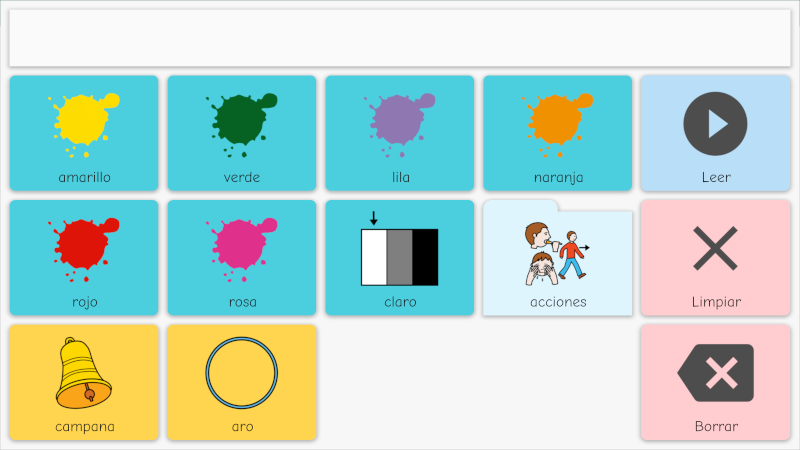
Logopedia Rosario - Campanas y aros
es
Trabajamos colores y longitud de enunciado
Compartido por: Nieves Molina

Asamblea
es
.
Compartido por: Ana Montes

Casa-Cole Pasar lista
es
Tablero básico nivel 1. Pasar lista, quién a venido al cole-casa. Colegio EE. Purísima Concepción Granada.
Compartido por: Carolina Palacios

Cuento Pocoyó
es
El Cuento de Pocoyó. Atención temprana.
Compartido por: Leire Buzunariz

Que llega el lobo - Cuento para Hugo
es
Adaptación del cuento "Que llega el lobo" para contar, hablar y aprender
Compartido por: Ana Quevedo Montes

¿Puedo mirar tu pañal? - Cuento para Hugo
es
Adaptación del cuento "Puedo mirar tu pañal" para contar, leer, hablar y aprender
Compartido por: Ana Quevedo Montes
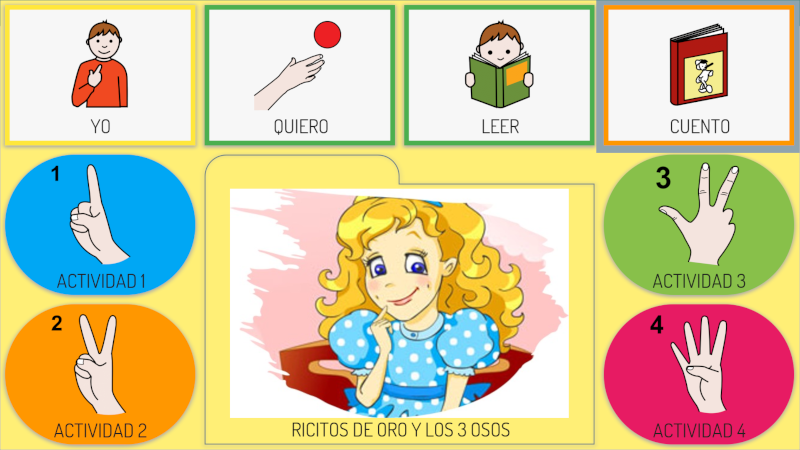
Ricitos de Oro - Cuento para Hugo
es
Adaptación del cuento "Ricitos de Oro y los 3 Osos" para contar, leer, hablar y aprender.
Compartido por: Ana Quevedo Montes

A qué sabe la luna - Cuento para Hugo
es
Adaptación del cuento "A qué sabe la luna" para contar, leer, hablar y aprender.
Compartido por: Ana Quevedo Montes

El Pollo Pepe - Cuento para Hugo
es
Tablero para contar y para hablar sobre el cuento de "El pollo Pepe", para un nivel de comunicador emergente.
Compartido por: Ana Quevedo Montes
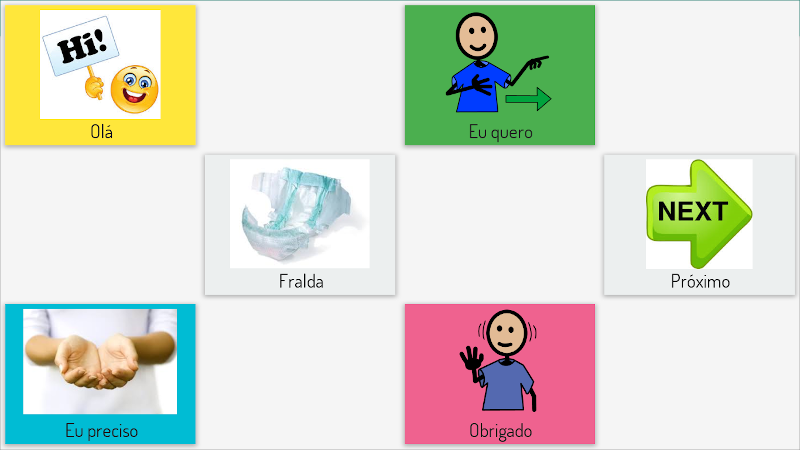
Tablero de comunicación
pt
(En
portugués)
Tablero de comunicación básica. Está diseñado con dos páginas Inicio y espacio suficiente para continuar añadiendo nuevo vocabulario gradualmente.
Compartido por: Adapt4you

Compras
pt
(En
portugués)
Tablero de comunicación para ir a la compra. Contiene diferentes categorías de productos, de medidas y de manejo de dinero. Recomendamos que lo modifiques, añadiendo los productos que compres más habitualmente.
Compartido por: Adapt4you

Taller de cocina, recetario
es
Se trata de un tablero de anticipación que incluye seis recetas clasificadas en seis categorías diferentes. Cada receta abarca dos páginas, una con los ingredientes necesarios y otra con los pasos a seguir. Podéis añadir nuevas recetas y categorías para ampliar el recetario.
Compartido por: Eneso

Piensa cómo termina el refrán
es
Consiste en averiguar cómo termina cada uno de los refranes que se plantean. Es una actividad que se puede realizar de manera individual o en grupo. Deben buscar en su memoria la terminación de cada refrán y contar el significado que creen que tiene. Podéis quitar y añadir cuántos refranes queráis.
Compartido por: Eneso

Identifica a la persona que aparece en la imagen
es
Consiste en identificar el nombre de varios cantantes, actores y actrices nacidos a lo largo del siglo XX en España. Al final de la actividad, podéis escuchar una canción de cada uno de los cantantes que aparecen. Pretende evocar en los usuarios experiencias pasadas.
Compartido por: Eneso

Quiero, no quiero - Control ocular
it
(En
italiano)
Tablero de comunicación de actividades de la vida diaria con más de 40 categorías para hablar de tus gustos y necesidades. Combina el estilo Verbo con colores, pictogramas y texto.
Compartido por: Ausilionline

Quiero, no quiero
it
(En
italiano)
Tablero de comunicación de actividades de la vida diaria con más de 40 categorías para hablar de tus gustos y necesidades. Combina el estilo Verbo con colores, pictogramas y texto.
Compartido por: Ausilionline

Tablero de comunicación
it
(En
italiano)
Tablero de comunicación básica. Está diseñado con dos páginas Inicio y espacio suficiente para continuar añadiendo nuevo vocabulario gradualmente.
Compartido por: Ausilionline

Carnaval - Explicación y canción
es
Tablero ambientado en la fiesta de carnaval que favorece la comprensión de qué es y cómo se celebra.
Compartido por: Eneso
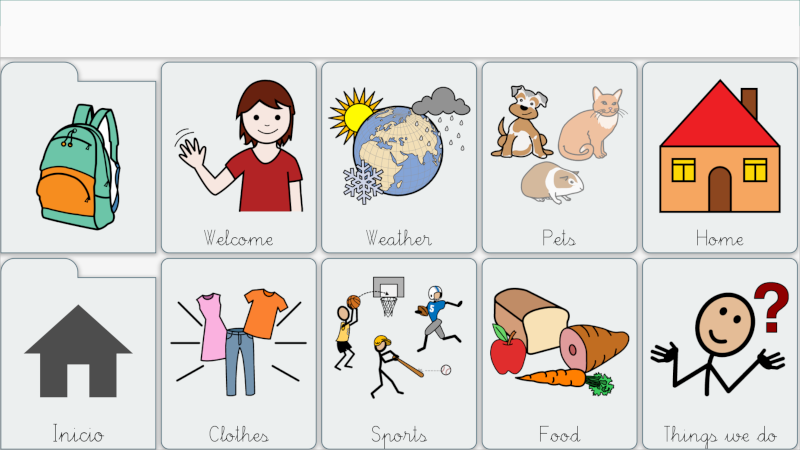
Inglés 3º primaria
es
Temario de 3º de Primaria de la asignatura "Inglés".
Compartido por: C.D.P. Padre Manjón. Granada. Teo Valderrama
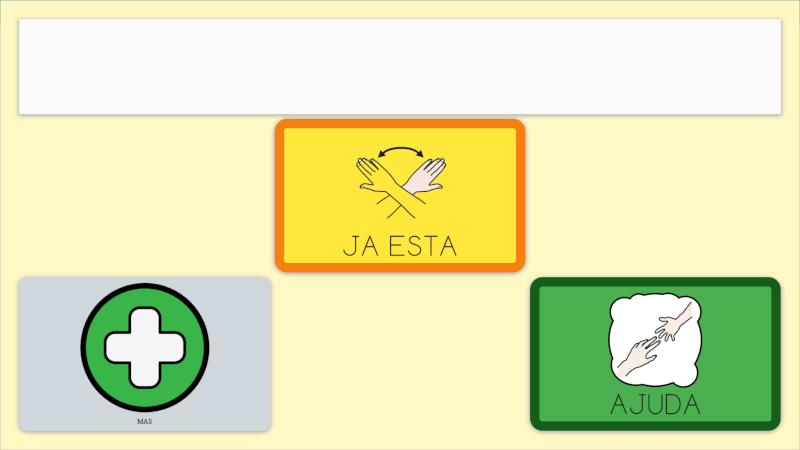
Working with puzzles
ca
(En
catalán)
Communication panel to ask for puzzle pieces, also to ask for help when it can not be put and finally to say it is done.
Compartido por: Montse Gonzalez

Voy a la compra - Notas
es
Tablero de comunicación para ir a la compra. Contiene diferentes categorías de productos, de medidas y de manejo de dinero. Recomendamos que lo modifiques, añadiendo los productos que compres más habitualmente. Esta versión incluye notas para guardar mensajes y recuperarlos después.
Compartido por: Eneso
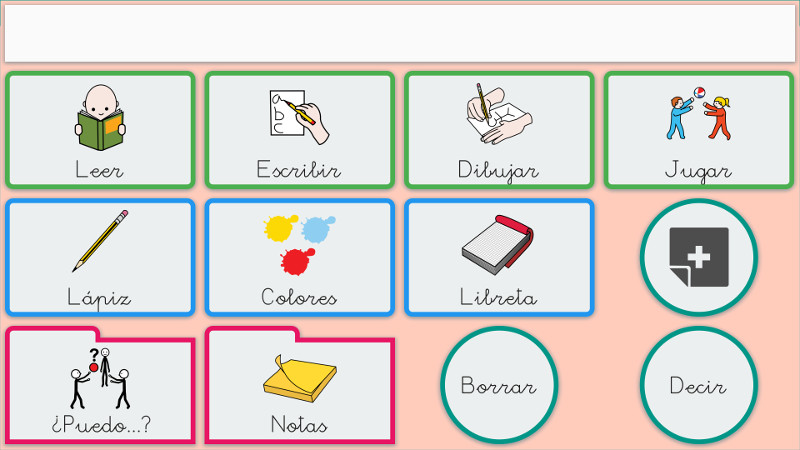
En el colegio - Notas
es
Tablero de comunicación en el entorno escolar que utiliza pictogramas y texto de letra enlazada en un estilo SAAC Bordes. Incluye página sobre acciones habituales y nombres de compañeros. Esta versión añade notas para poder guardar mensajes y decirlos más tarde.
Compartido por: Eneso
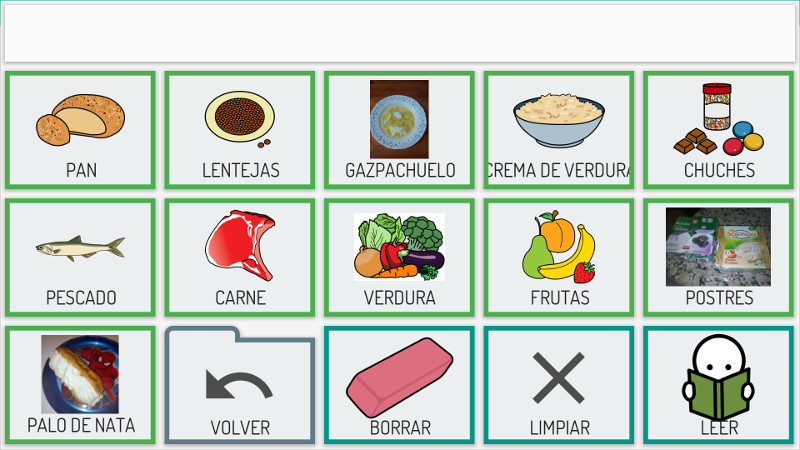
Tablero de Alejandro
es
Tablero personal con mensajes para la comunicación básica. Está diseñado con distintas páginas y espacio suficiente para continuar añadiendo nuevo vocabulario gradualmente.
Compartido por: Ángeles Gil

Juego de sumas simple
es
Actividad de sumas sencillas con números enteros. Atiende al cálculo propuesto en cada nivel la manzana con la respuesta correcta.
Compartido por: Eneso

El elefante naranja
en
(En
inglés)
Érase una vez un elefante de color naranja... Descubre la divertida historia del elefante naranja ¡y añade más personajes a este cuento interactivo! Incluye actividades sobre la historia.
Compartido por: Sonja Higham

Comunicación básica
en
(En
inglés)
Nuevo tablero de comunicación básica creado por la terapeuta Sonja Higham desde Sudáfrica, que utiliza imágenes y texto (en inglés). Está diseñado con dos páginas Inicio y espacio suficiente para continuar añadiendo nuevo vocabulario gradualmente.
Compartido por: Sonja Higham

Reconocer los verbos
es
Actividad de iniciación al análisis sintáctico. Lee la frase y localiza la acción que se lleva a cabo en cada una de ellas.
Compartido por: Eneso

Semana Santa
es
Tablero de anticipación del periodo de Semana Santa con el vocabulario y los acontecimientos típicos de esta fecha en España.
Compartido por: Eneso

Mis sentidos
es
Aprendemos más sobre nuestros cinco sentidos de forma visual y con ejemplos de actividades cotidianas. En este tablero se utilizan pictogramas de Arasaac y Symbolstix en combinación con texto.
Compartido por: Eneso

Calendario de adviento
es
¿Con ganas de que llegue la Navidad? ¡Con este calendario de adviento la espera será más corta! Realiza las distintas actividades propuestas para cada día y diviértete con la cuenta atrás para las fiestas.
Compartido por: Eneso
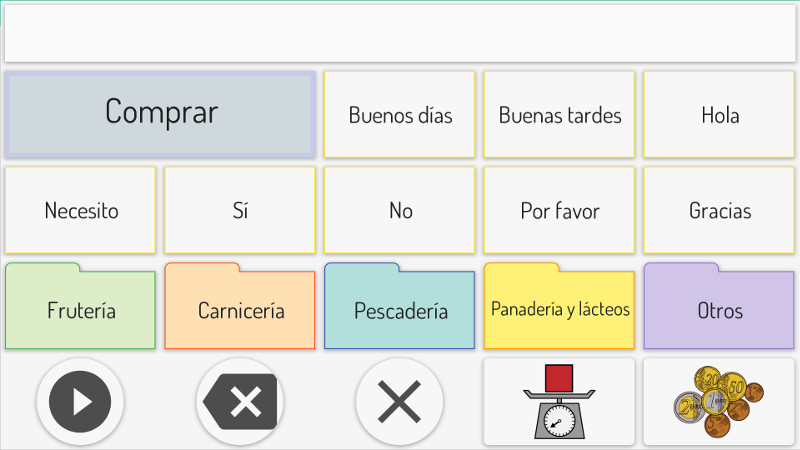
Voy a la compra
es
Tablero de comunicación para ir a la compra. Contiene diferentes categorías de productos, de medidas y de manejo de dinero. Recomendamos que lo modifiques, añadiendo los productos que compres más habitualmente.
Compartido por: Eneso













































































